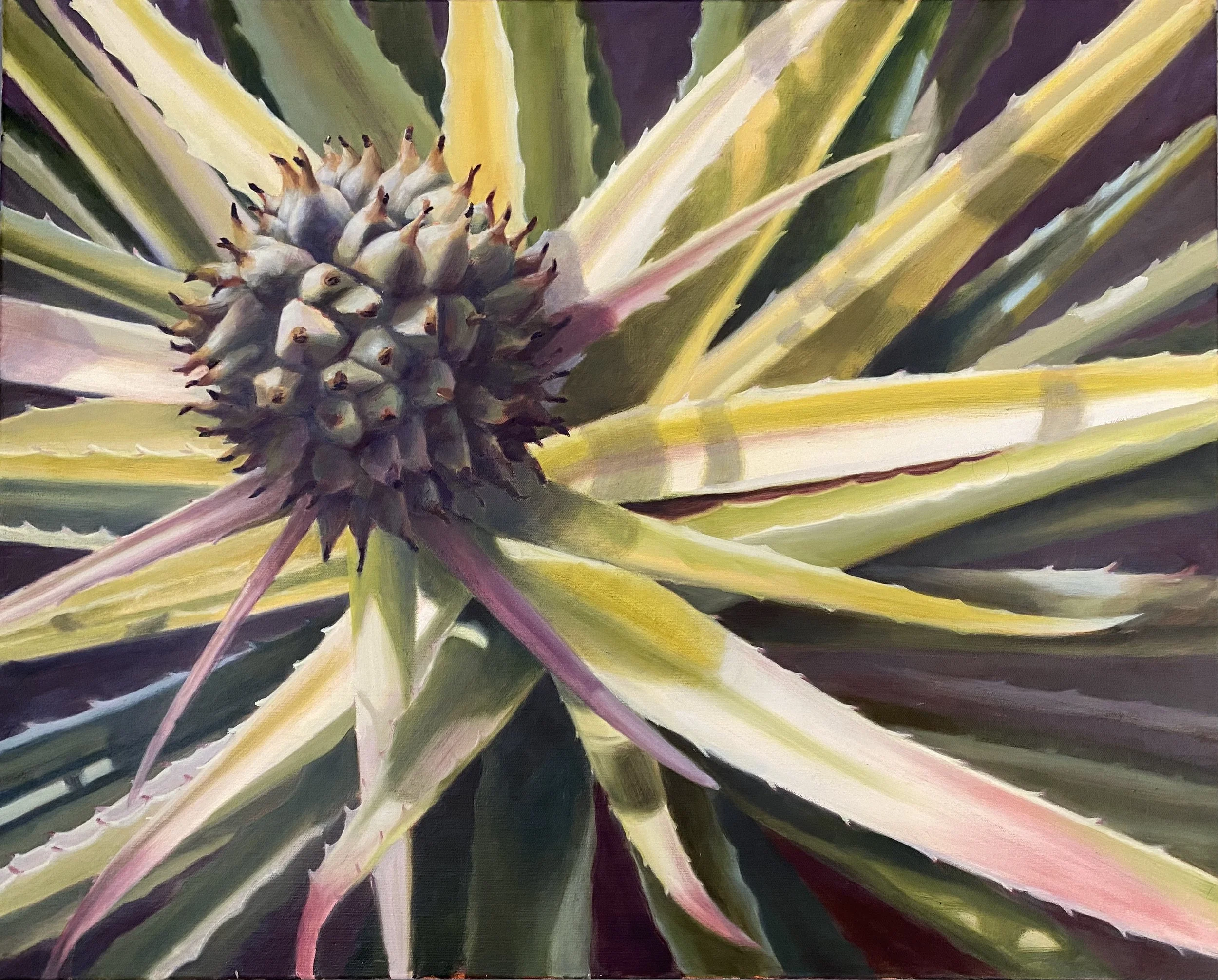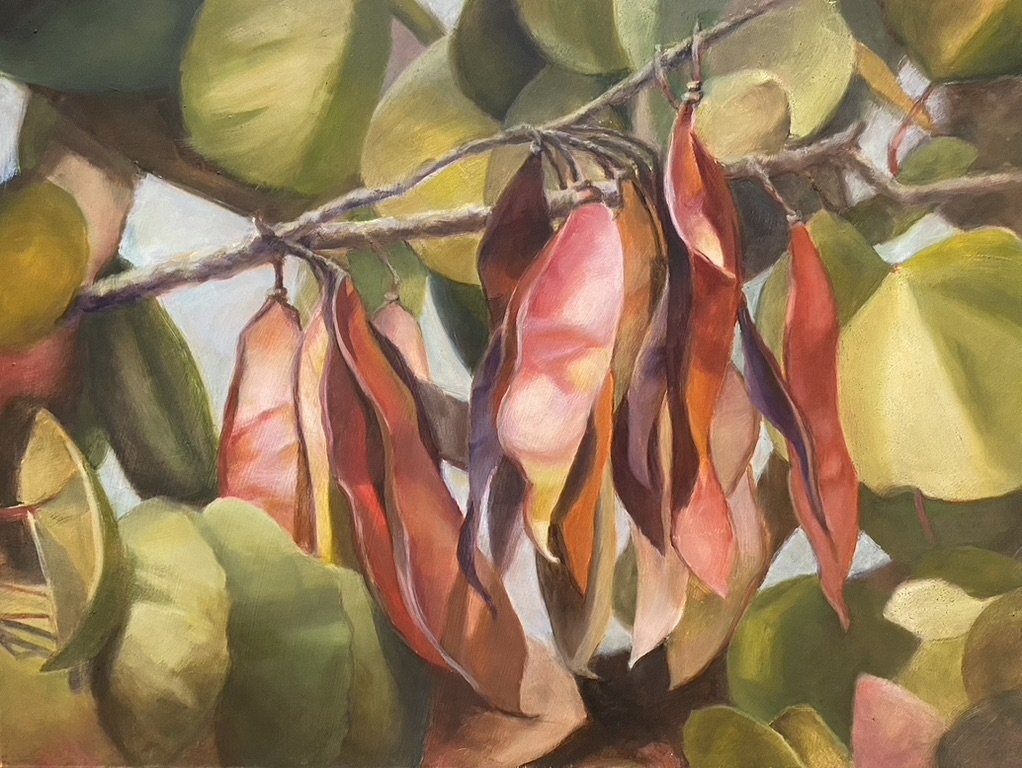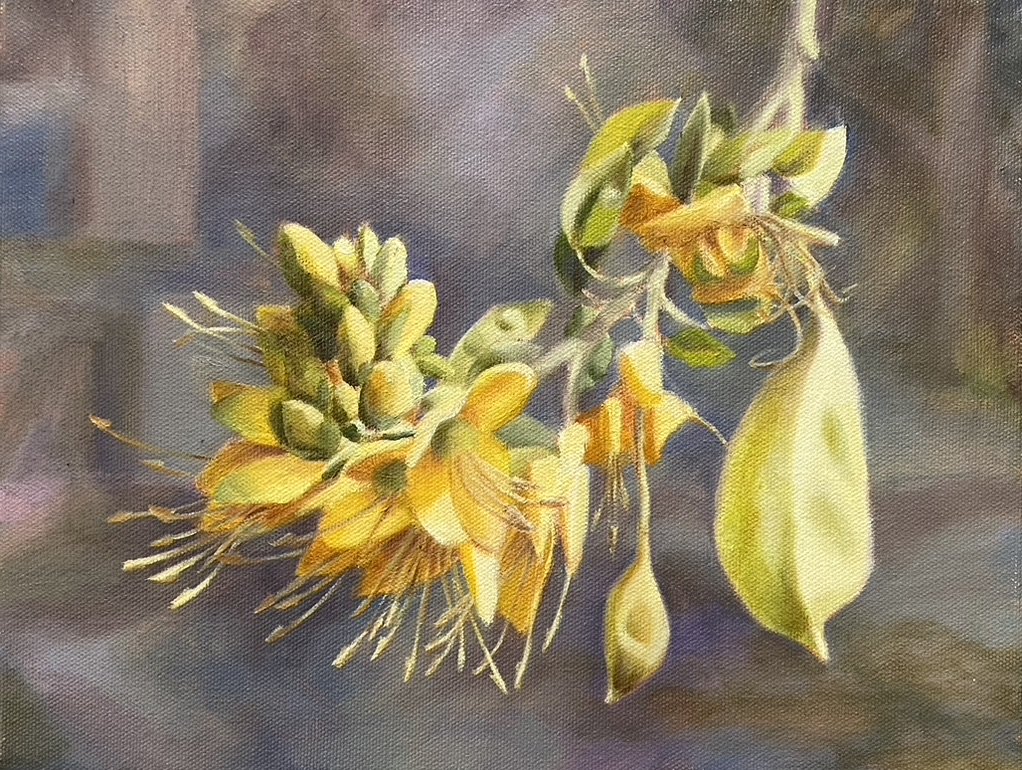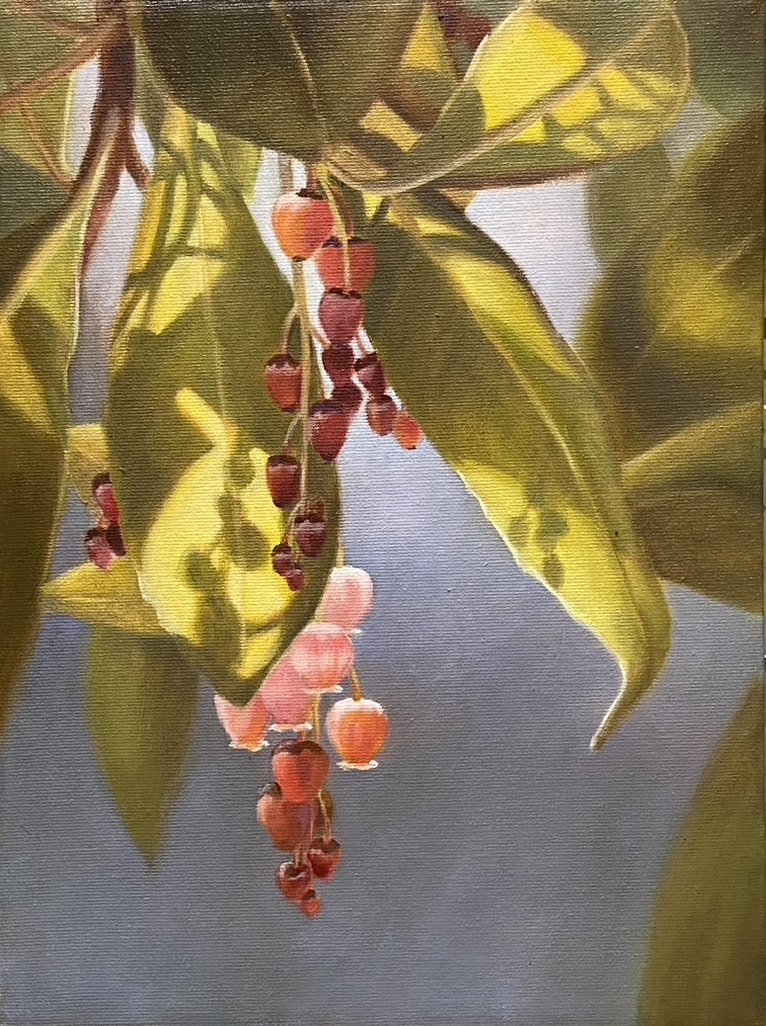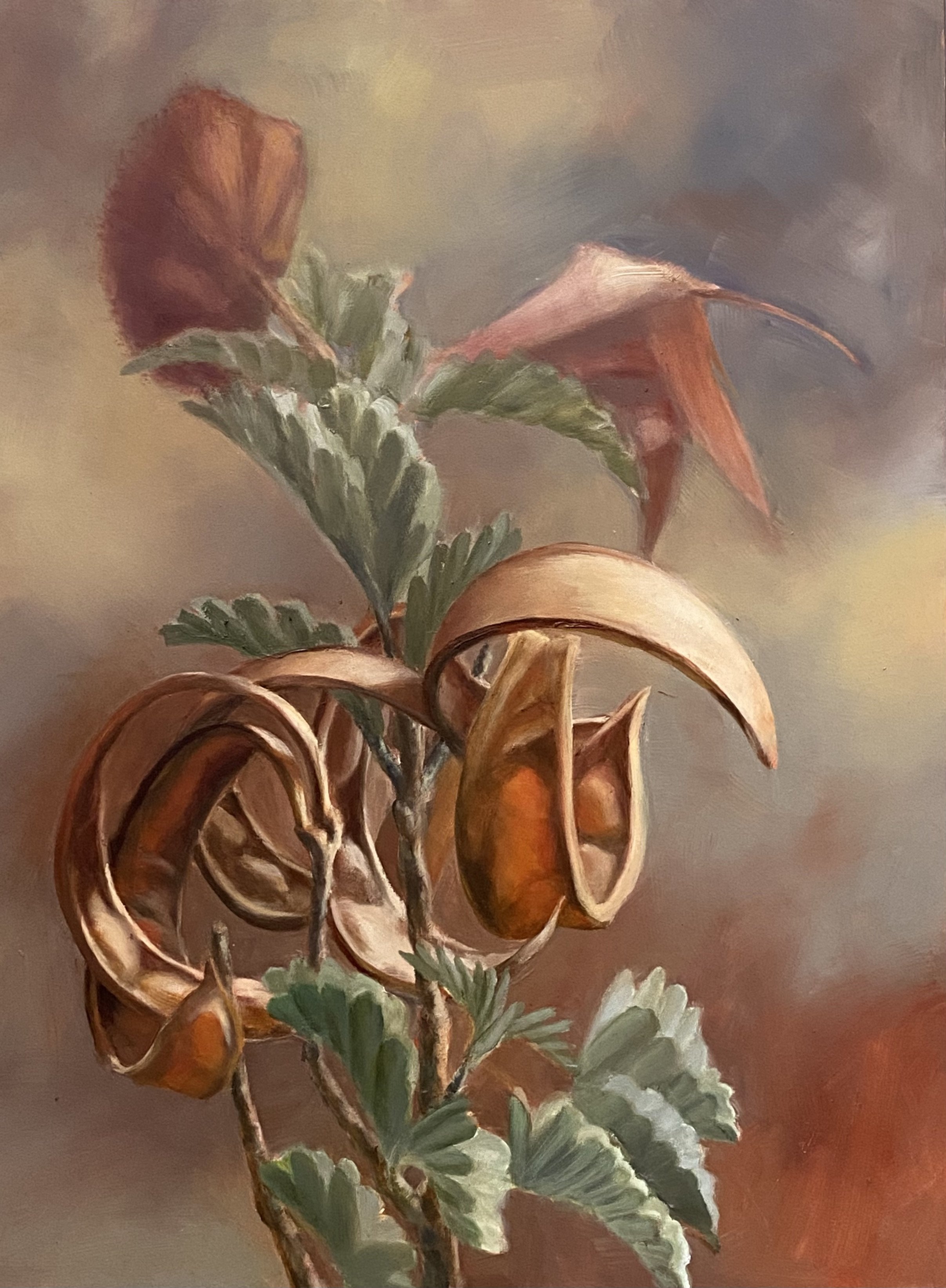Building The Next Generation
This series, “Building the Next Generation” is inspired by a burst of fertility in my family. Admiring our children’s bold step into parenthood at a seemingly precarious time reminds me of the insistent power of procreation. Every life form is constantly in the act of building its next generation, perpetually moving life forward. This process is clearly and beautifully seen in plants, the cycle of flower, fruit, and seed makes nature’s powerful drive to perpetuate life beautifully visible.
The Mulberry Tree, 16x12 oil on panel
Since childhood I knew of Mulberry bushes thanks to the well known childhood rhyme but I had never seen one until a friend and I indulged in an afternoon of visiting gardens together. We parked across the street from a magnificent tree that my friend informed me was a Mulberry. I took so long admiring it I had to send her on and promise to catch up. The clusters of fruit go from white to green to yellow and then turn from pink to red to deep purple as it ripens. The colorful fruit are nestled in among brilliant green leaves with a scalloped edge. I think the silk worms who feast exclusively on Mulberry leaves chose well!
Catching the Last of the Sun (Yellow Berries) 10x8 oil on panel
Trailside Lemonade Berry, 24x36 oil on canvas
The hills of coastal southern California and northern Baja are covered with this hardy shrub. From 3 to over 20 feet high, this chaparral plant sprawls over the hillsides. Leathery evergreen leaves grow from thick reddish branches and after tiny white blossoms drop, the fruit, covered with white hair, grows at the ends of branches in tight clusters. I associate this plant with the pleasant time I spend on the trails around my home.
Early Spring Lupin, 12x9 oil on canvas, Sold
In the canyon where I live in Southern California spring announces itself with a field of tiny lupin pushing up through the grasses. I’m thrilled when I see the tiny blue buds that will turn into upright stalks ringed with flowers. Not only do they paint hillsides blue, they serve as food for butterfly and moth larva plus the plants fix nitrogen from the atmosphere into the soil, fertilizing it and pioneering change in inhospitable environments. There are so many reasons to love lupin!
Neighborhood Loquats, 16x20 oil on canvas
Loquat trees and bushes grow in many gardens and yards in Southern California. Their bright and abundant fruit reminds me of when the area was more agrarian and kids didn’t hesitate to pick fruit that happened to look tasty. When I see a loquat leaning over a fence seeming to offer powerfully scented and sweet fruit I remember the generous time and place I was lucky enough to grow up.
Rosaria’s Garden, 20x10, oil on canvas, Sold
Backyard Citrus, 24x18 oil on panel
Southern California’s agricultural heritage has left dense green citrus trees dotted throughout older residential areas. The first residential lots created from the old farms and ranches were large and parts of former orchards were left standing as a beautiful buffer between neighbors. Orange, lemon, lime and grapefruit provide splashes of color and continue to produce backyard fruit year after year throughout the southland.
Santa Barbara Seedpods, 12x16 oil on panel
Returning to the town where I went to college always includes lots of walks. My brother and sister-in-law and I spend our mornings walking under old oaks and eucalyptus, alongside artfully stacked stone walls and gracious homes while rarely losing sight of the ocean. We passed under this tangle of pods on one of our meanderings.
Delicate in the Desert (Bladderpod), 9x12 oil on canvas
The plant this delicate flower grows on is called a Bladderpod due to the form of it’s seedpods but it is commonly referred to as a Spiderflower which certainly does a good job of describing it’s long legged blossoms. It grows in dry washes and hot arid areas of Southern California and the Baja Peninsula. The plant emits a foul odor to discourage anything giving thought to eating it which I think must be the doing of those odd pods!
Arbutus Flowers, 12x9 oil on canvas
I don’t know if I’ll ever tire of painting Arbutus. The shrubs take a beautiful shape, have gorgeous red bark and on any given day look spectacular. In Spring these delicate trailing pink and white flowers decorate the branches and create an eye catching contrast to the deep green glossy leaves. Five months later the plant puts out beautiful multi-colored fruit. How can you resist falling in love with Arbutus?
The Strawberry Tree, 16x20 oil on panel
Yup, arbutus again! I cant help myself.
Tender and Brilliant, 16x20 oil on panel
A column of sunlight ignites bright new growth creating as sharp a note as a baby’s cry in the shade of a hushed forest.
Coastal Pittosporum, 36x24 oil on canvas
The Pittosporum is a decorative plant used extensively in landscaping in Southern California. It has small white flowers that are sweetly scented and fruit that bursts open on ripening to release it’s sticky seeds. It is primarily planted for its attractive long lance shaped leaves that have lovely wavy edges. Recently many of our coastal Pittosporum have turned a bright yellow.
Eucalyptus Seed Husks, 20x16 oil on panel, Sold
I love eucalyptus trees. Their distinctive silhouette has always punctuated my favorite vistas, their fragrance moves through my home and their uniquely muscled branches supporting ribbons of swaying blue green leaves offer a vision of strength and grace that I wish the rest of the world would strive for.
Eucalyptus are a necessary part of my series “Building the Next Generation” not only because I’ve lived my life under them but because they are an amazing expression of nature’s powerful intent to propagate. Eucalyptus often bear flower buds in formation, blooming flowers, pollinated but still immature seed capsules and fruit reaching maturity in addition to older, empty seed capsules from previous seasons. That’s every phase of reproduction happening at once. You have to love that the grandmothers, the husks that have released their seeds, just hang around to enjoy it all once they’re done!
Baja Fairy Duster, 16x12 oil on panel
I came across this plant while walking with a friend in the Coachella Valley in Southern California. The twiggy plant had scarlet tufted flowers which were beginning to droop. The long red stamens had gone a little rusty and and looked like a long used powder puff looking forward to retirement. What drew my eye were the seed pods looping into and around one another seemingly enjoying one another’s company before they crack open and release their seeds.
Dog Rose Hips, 14x18 oil on panel, Sold
Following my daughter down a wooded path on a drippy afternoon in Denmark I was stopped by these gorgeous rose hips. They shone like apples in the tangle of their canes and called out to me to touch them or perhaps eat them. It turns out I wouldn’t have suffered any Alice in Wonderland consequences, native cultures have included the hips of the Dog Rose in their cuisine for centuries. Tea, jams, breads, wines and a favored Swedish soup all deliver the high level of vitamin C and antioxidants found in the beautiful fruit of the Dog Rose.
Acorns to Oaks, 30x24 oil on canvas, Sold
I’ve loved acorns since childhood. They littered the shady spots where my family spent some of it’s happiest days. The acorn’s smooth surface nestled perfectly in my palm and I marveled at how such a small perfect thing could create such big beautifully tangled trees. I wondered how many animals would make meals of all the scattered nuts and was entranced by the nut’s cup shaped cap that fit perfectly on the tip of my finger - weren’t they just perfect elf caps?
The oak remains one of my favorite trees and acorns can be found in bowls and on window sills around my house and they appear frequently in sketch books, prints and paintings I’ve made over the decades, this being the most recent.
Hope and Endurance, 24x18 oil on panel
I associate the uniquely sculptural prickly pear with the dry and rugged hills and deserts I have spent my whole life exploring. What we used to simply called cactus rises majestically above the low grasses and scrub with paddle growing out of paddle haphazardly, as if a toddler popped together the disks.
In late spring the plant produces its flowers of yellow, red or purple. The juxtaposition of the delicate brilliant flower and its generous fruit with the leathery and often spined paddles is remarkable and no doubt why the plant is seen as a symbol of hope and endurance.
Red Gum, 24x36 oil on canvas
Like me the Red Gum, a variety of eucalyptus, prefers temperate coastal conditions and does well with salt spray. It’s dense glossy leaves, dark above with a pale underside offer deep and welcome shade. It flowers several times a year in spectacular fashion, putting out large sprays of fluffy red, pink and yellow flowers in sprawling clusters that float on a field of rich green leaves. The urn shaped seed pods are beautifully and move from green to purple to brown as they remain on the tree.
Fierce Offering II, 24x30 oil on canvas
Some 200 species of Agaves grow in the arid regions of the Americas and they easily create hybrids between species. The secret to their survival is their shallow root system that makes the most of scant rain as well as condensation and dew.
I love not only the plant’s adaptability, but the countless sculptural and colorful forms it takes. Thriving in harsh settings, it tells me that beauty can happen anywhere and that hardship can build beauty. This fierce skyward thrust of a ball of seeds expresses to me the power of adaptability.
Eucalyptus Starbursts, 12x16 oil on panel, Sold
Returning home after evening walks I am often offered countless versions of this lovely multi layered sight.
From Ancient Rootstock, 16x20 oil on panel, Sold
The practice of grafting new varieties of apples to older rootstock is a longstanding practice. Newly desirable varieties are spliced into older plants and will will become one with the rootstock within 2 weeks. The trunk and roots of older trees that have proved their ability to effectively extract water and minerals from the soil and resist pests, diseases and drought nourish and protect branches bearing a new variety of fruit. Isn’t that just the best analogy for a good family you’ve ever heard?
Artichokes, 16x20 oil on panel
Artichokes grow wild on the plateaus I have walked my whole life. 4 to 6 feet tall, they are majestic plants and place bursts of purple above the scrub when they flower. The plant is a variety of thistle and has been cultivated regionally as a food since the 8th century BC. I remember my mother teaching our relatives visiting from New England how to pluck a leaf off a cooked artichoke, dip it a lemony Hollandaise Sauce she made, pull it through their teeth and toss what remained into the quickly filling bowl in the middle of the table. Wild, beautiful and delicious - who doesn’t love the artichoke?
Springtime Natal Plum, 10x20 oil on canvas
In the area I grew up it was important to learn to identify this plant early in life. Natal plum was a popular accent plant in the yards where we played hide and seek at dusk diving into bushes with abandon. Beneath the glossy green leaves of the natal plum are some wicked thorns that you needed to encounter only once to leave a lasting memory. It took me years and a much more civilized interaction with gardens to forgive the plant for its barbs and notice the beautiful fruit and the star shaped flowers that smell as sweet as the orange groves that once defined our region.
Arbutus in Winter, 24x36 oil on Canvas, Sold
I love Arbutus Undo, also known as the Strawberry Tree, so much that I have planted 4 on my property. They have a beautiful brick red trunk and bright red branches, glossy green leaves and seasonally produce delicate bunches of cascading bell shaped white flowers. To me the real treat is that it produces fruit in red, orange and yellow that remain on the tree for months and months and look for all the world like artfully hung ornaments!
